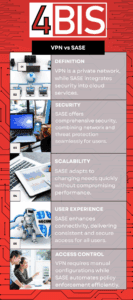SASE vs. VPN
Cyber criminals never stop, so neither should your business security. You run your company. Meanwhile, hackers look for old defenses. Processes for remote work once seen as a viable option, like VPN, are now considered a weakness.
VPN problems are everywhere. They hit major firewall makers. What happens when your firewall fails? Your whole network is vulnerable. VPN is wide open to threats.
Meet SASE (Secure Access Service Edge) pronounced “sassy”. This new security uses the cloud and protects better than VPNs. SASE is also easier to use.
What Is SASE?
SASE is one of the most secure frameworks for remote and hybrid work. SASE combines network and security functions. Including SDWAN, Zero Trust Network Access (ZTNA), cloud firewalls, and threat prevention into a single cloud delivered service.
VPNs funnel all traffic through a centralized point (creating bottlenecks and single points of failure). SASE enables secure, direct to cloud access with real time threat detection and policy enforcement.
The Problem with VPNs in 2025
VPN security problems soared in 2024. More than 133 weak spots for VPNs became public. This was up 47% from the year before. Companies such as Cisco, Fortinet, Citrix, Palo Alto, Ivanti, and Check Point all faced major risks.
SonicWall VPN Zero-Day Alert: What You Need to Know
Even fully patched devices with Multi-Factor Authentication (MFA) enabled have been compromised. This strongly suggests that a zero-day vulnerability is being exploited.
Once attackers gain access, they don’t waste time. They escalate privileges, steal credentials, disable security tools, and deploy ransomware—often within just hours of gaining initial access. These attacks have affected multiple organizations across sectors. They are particularly concerning for manufacturers and SMBs who rely heavily on outdated infrastructure and continuous uptime.
SonicWall has acknowledged the situation and is urging administrators to take immediate action:
- Disable SSL VPN (if possible)
- Restrict remote access to trusted IP addresses
- Enable botnet filtering and Geo-IP restrictions
- Audit user accounts and enforce MFA
- Monitor for firmware updates and apply them as soon as they are available
- This attack campaign is a textbook case of why layered security and regular risk assessments are critical. Even well-known, widely trusted hardware and software can be vulnerable to zero-day threats. If your business is relying on the status quo for cybersecurity—you’re already behind.
Protect your network before it becomes the next target.
Why did this happen? VPNs have some key flaws. They rely on central firewalls, but attackers are simply going around them. Many VPNs are often not up to date and/or are often set up incorrectly.
VPNs give wide access to your internal network. Access should only be for specific roles or needs. If an attacker breaks through a VPN, they often get into everything. This creates an all-or-nothing security risk.
Why SASE Is the Better Choice
Here’s why more companies (including 4BIS and our clients) are replacing VPNs with SASE. More companies pick SASE. They switch from VPNs. 4BIS and our clients do this too.
- Stronger Security: SASE uses Zero Trust. Every device and user must confirm who they are. Access is limited by job and need. Always-on firewalls help. Data is encrypted. Since monitoring happens in real time. SASE greatly cuts chances of attack.
- Easier to Use: Employees can log in with familiar Office 365 credentials, creating a smoother experience compared to VPNs. After implementing SASE, our internal employees and many of our customers report working from home feels just as efficient as being in the office
- Built to Grow: SASE fits any business. It works for 10 or 1,000 employees. It lives in the cloud. IT teams manage rules and users easily. No complex setup is needed.
- Access by Role with Zero Trust: SASE ensures users get only what they need. A receptionist has different access than finance staff. Even if a device is taken over, the attacker is limited to the permission level the user has.
- Ready for Tomorrow: Online threats change daily. SASE has deep logs. It checks for threats. Policy tools help IT teams. They find dangers before big problems start.

Our Own Story: SASE Made Us Safer
At 4BIS, we moved to SASE. This helped our remote staff. We saw changes right away.
We got rid of open VPNs. We no longer rely on one firewall. Employee support calls dropped. Protection follows users everywhere. This includes the office, home, or public Wi-Fi.
How We Set Up SASE for Clients
Our setup process is straightforward. Our IT team pushes out the software to employees’ devices. We provide our clients with instructions on how to authenticate using Microsoft Office 365 credentials and Multi-Factor Authentication (MFA).
Individuals can often authenticate themselves without assistance from our staff. For anyone that wants help we offer full support. The end-user experience is seamless, fast, and secure.
What to Know Before You Switch
SASE is powerful. Even so, keep some things in mind. This helps make sure setup goes well.
BYOD (Your Own Device)
SASE works best on company devices. Your personal phone or laptop might not be safe enough. This creates a risk. If you use SASE, make sure every device is secure.
Is SASE Right for Your Business?
If you’re still relying on outdated VPNs, now is the time to modernize. SASE delivers the security, speed, and scalability your remote workforce needs. With cyberattacks targeting VPN vulnerabilities, protecting your network with a layered, cloud first solution is a necessity. Talk to us about how to ensure a smooth transition.
At 4BIS Cyber Security and IT Services, we’re committed to helping businesses understand and manage their cyber risks. Let’s talk about your security. Reach out to 4BIS to see how we can help you eliminate VPN risks, secure your hybrid workforce, and simplify remote access.

